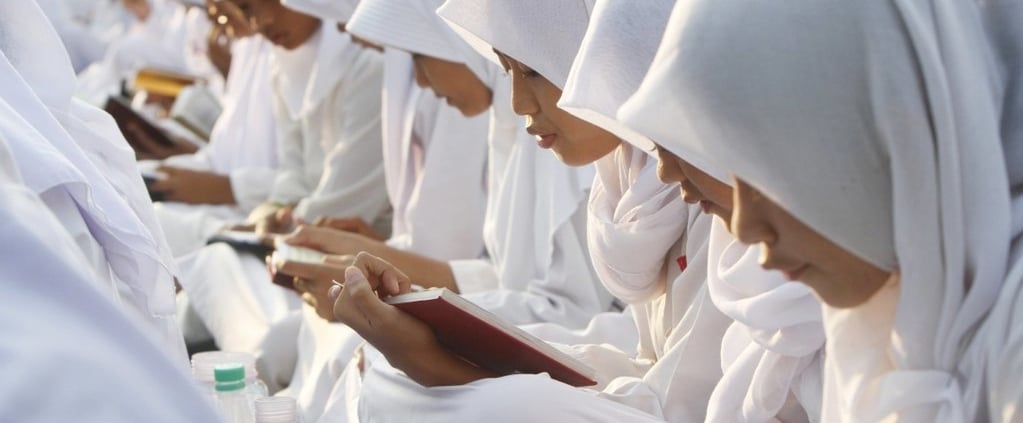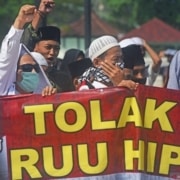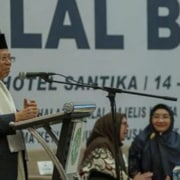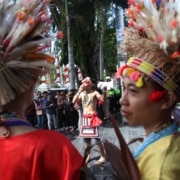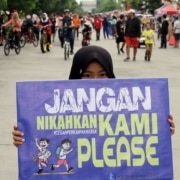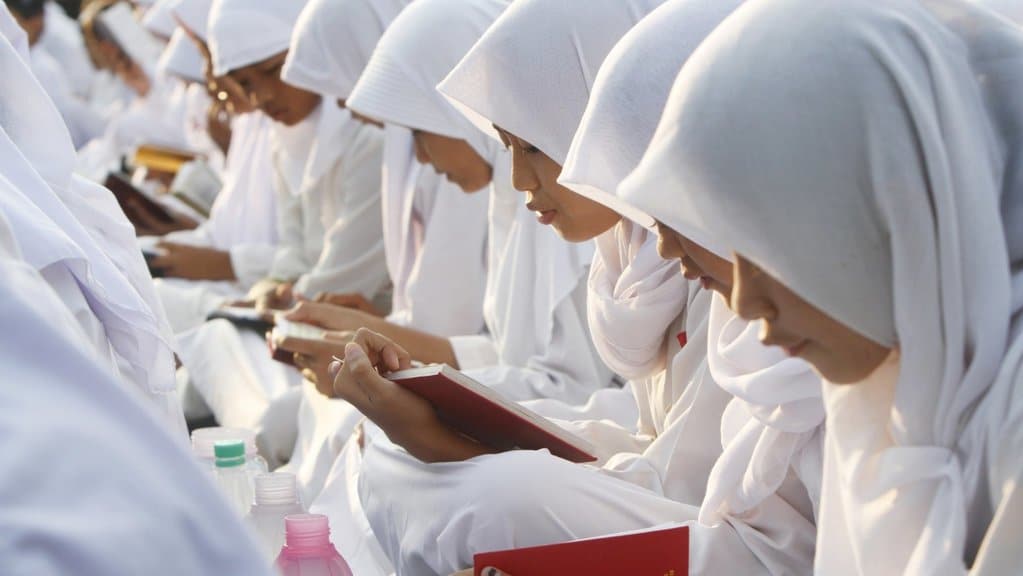
Many regional governments across Indonesia have issued local regulations requiring female students to wear Islamic dress. Photo by Regina Safri for Antara.
After years of inaction, the Indonesian government is finally acting to prevent state schools from forcing students or staff to wear headscarves or other religious clothing. On 3 February, the Ministry of Education and Culture, the Ministry of Home Affairs and the Ministry of Religion issued a joint ministerial decision on uniforms for students, teachers and staff in primary and middle schools.
The decision states that any local regulations enforcing (or banning) religious clothing in schools must be revoked within 30 days, or schools and local leaders will face sanctions, such as cuts in funding.
It is no coincidence that this decision came just days after widespread media coverage of a state technical school in Padang, West Sumatra that had been forcing all female students, Muslim and non-Muslim alike, to wear the headscarves. The issue came to national attention after a mother of a non-Muslim student posted a Facebook video complaining about the policy, which quickly went viral.
But the school was, in fact, simply following a regional bylaw, implemented since 2005, requiring all female students to wear headscarves.
It is not clear why the policy went viral now, more than 15 years into its implementation, when this is an issue that women’s rights and religious freedom activists have been highlighting for more than a decade. But the bizarre defence of the policy by the former mayor of Padang who issued the bylaw surely did not help. He said the policy was necessary to protect female students from being bitten by mosquitoes.
The joint ministerial decision is important because headscarves have become a contested topic in Indonesia in recent years. Religious clothing is often used as the basis for discrimination and a way to control women’s bodies. Critics say the choice to wear a headscarf should be a personal religious choice, not something that is forced or compulsory.
In fact, Indonesian women have chosen to wear headscarves for hundreds of years. They were known by different names among different ethnic and cultural groups, such as kudung (Javanese and Sasak), tiung (Sunda), tengkuluk (Minang), rimpu (Bima) and ija sawak (Acehnese) and considered part of Indonesian (Nusantara) identity. The country’s inaugural first lady, Fatmawati, wore a loose headscarf as a representation of national identity for the newly independent Indonesia. She regularly wore the scarf with a kebaya blouse and batik sarong at formal events.
However, headscarves began being worn more often as a marker of political identity following the Iranian Revolution in 1979. Over time, efforts were made to strengthen the theological basis for the wearing of head coverings, and there was a surge in religious texts supporting a requirement for female Muslims to wear head scarves. These developments occurred alongside the growth of political Islamist movements in Muslim majority countries.
In Indonesia, debate about the wearing of headscarves in public began during Soeharto’s New Order period. Under the New Order, political Islam was suppressed, and the headscarf was seen as linked to it, and so viewed with a degree of suspicion. At formal state events, the kebaya was worn without a head scarf. During this time, even women from the two largest Muslim social organisations, Nahdlatul Ulama and Muhammadiyah, did not often wear head scarves, unless they were elderly or practiced a more orthodox version of Islam (santri).
In the early 1980s, several high school students caused controversy by wearing headscarves at a time when the government outlawed wearing them in state schools, viewing them as political symbols. In fact, under the New Order, female students who wore headscarves faced considerable discrimination. They were expected to take off their scarves or move to a private school.
During this time, human rights activists defended students’ choice to wear headscarves based on their right to freedom of religion. But over recent years, the situation has reversed. As Indonesian Islam has moved in a more orthodox direction, headscarves have become viewed as a binding or even compulsory religious rule. Those who do not to wear a headscarf are pressured or forced to wear the veil, sometimes even if they are non-Muslim.
Regional autonomy and direct elections for regional heads have also encouraged the development of local policies based on religious sentiment. Aceh, for example, began implementing shari’a after being granted special autonomy in 2001, and compulsory headscarves for women was one of the first rules to be implemented.
Many other regions have implemented shari’a-inspired regional regulations designed to appeal to majority Muslim populations. These include not only requirements for females to wear headscarves, but also bans on gambling, alcohol, restrictions on mobility during evenings, and other associated ‘public order’ and morality issues. Many of these policies, such as requirements for headscarves in schools, appear designed to control the behaviour of women and girls.
But as headscarves have become regulated, they are no longer simply an expression of cultural or religious identity. When made compulsory through regulation, headscarves actually lose some of their religious meaning. The implementation of these regulations is not solely about faith or belief, rather the rules are applied to all. As such, the religious significance of headscarves becomes lost.
Worse, policies on headscarves are not always clear. Sometimes there is no formal regulation, in other cases, it may come in the form of a decision from a district head, as in Padang. Sometimes the regulation is only applied to Muslims, in other cases, to all female students.
But even without a formal policy, it is not surprising that some non-Muslim students sometimes wear headscarves ‘by choice’, to avoid being viewed differently by their peers or teachers. Standing out in an environment where differences are used to divide is not a pleasant experience.
Before the joint ministerial decree was passed, schools had a choice. Were headscarves under the domain of religion or the school? If headscarves were viewed as a religious rule, then there was no need to make them compulsory; wearing a headscarf was a matter of personal religious interpretation. When headscarves are made compulsory by the school, however, they are little different to a uniform.
Rather than a step toward banning wearing of headscarves, as occurred under the New Order, this new joint ministerial decree is an attempt to return the headscarf to the religious domain. Islamic scholars differ in their views on whether headscarves are obligatory. As such, the joint ministerial decision’s emphasis on choice is much more appropriate than a ban.
What is not covered by the decision is the problem of coercion. In a society that is growing more conservative, and a political culture that emphasises identity politics, headscarves are generally viewed as mandatory.
In this environment, it is important that education providers do not use their power to persuade or coerce girls to wear headscarves, even in the absence of a formal regulation making them compulsory. Likewise, Islam’s proponents should be honest and acknowledge that headscarves are not an obligation.
We are fortunate to have a minister of religion who understands the difference between provisions in the Qur’an and the provisions of the Constitution. He understands what are matters of religion and what are matters of state. The interests of the nation should come before the interests of one religious group, even if it is the majority.
An earlier version of this article was published as “Merebut Tafsir: De-syariatisasi Jilbab?” on 25 January on the Rumah Kitab blog.


